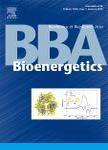版权所有:内蒙古大学图书馆 技术提供:维普资讯• 智图
内蒙古自治区呼和浩特市赛罕区大学西街235号 邮编: 010021

作者机构:UNIV PARIS 11UTILISAT RAYONNMENT ELECTROMAGNET LABF-91405 ORSAYFRANCE
出 版 物:《BIOCHIMICA ET BIOPHYSICA ACTA》 (Biochim. Biophys. Acta Bioenerg.)
年 卷 期:1987年第894卷第2期
页 面:138-145页
核心收录:
学科分类:0710[理学-生物学] 071010[理学-生物化学与分子生物学] 07[理学]
基 金:Royal Society (2274)
主 题:Chlorophyll fluorescence Electron transfer Photosynthesis Photosystem II Protein phosphorylation (Pea and lettuce chloroplast) Chl chlorophyll D1 herbicide-binding protein ( psbA gene product) D2 protein associated with PS II ( psbD gene product) DCMU 3-(3,4-dichlorophenyl)-1,1-dimethylurea DPC diphenylcarbazide DPIP 2,6-dichlorophenolindophenol F 0 initial Chl fluorescence F M maximal Chl fluorescence Hepes N -2-hydroxyethylpiperazine- N ′-2-ethanesulphonic acid LHC light-harvesting Chl a b protein complex pBQ phenyl benzoquinone PQ plastoquinone PS Photosystem Q A primary quinone electron acceptor of PS II Q B secondary quinone electron acceptor of PS II
摘 要:Chloroplast thylakoid membrane protein phosphorylation inhibits Photosystem-II-mediated electron transfer at saturating light intensities. Measurements of room temperature chlorophyll fluorescence have been used to monitor electron transfer reactions between the primary (Q A ) and secondary (Q B ) quinone acceptors of Photosystem II. The initial transfer from Q − A to Q B is not affected by the phosphorylation, although a second slow reoxidation phase is even slower after phosphorylation. After equilibrium is achieved between Q − A Q B and Q A Q − B there appears to be a higher concentration of Q − A in the phosphorylated membranes. This is explained by a phosphorylation-induced destabilisation of the anionic semiquinone, Q − B , as seen from the DCMU-stimulated fluorescence increase.